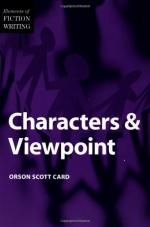
|
| Name: _________________________ | Period: ___________________ |
This test consists of 15 multiple choice questions and 5 short answer questions.
Multiple Choice Questions
1. What is a viewpoint narrator?
(a) One that observes and comments on the narrative from the perspective of a single character.
(b) One that observes and comments on the narrative from the perspective of only the minor characters.
(c) One that observes and comments on the narrative from the perspective of the reader.
(d) One that observes and comments on the narrative from the perspective of only the major characters.
2. Why do some readers interpret a change in a character that was not written to change?
(a) The reader did not understand the character when reading about it.
(b) The author did not understand the character when writing it.
(c) The author did not understand the reader.
(d) The reader did not understand the plot.
3. Which type of narrative is most often used when writing from a Representation perspective?
(a) Second person.
(b) Third person.
(c) First person or second person.
(d) First person.
4. What can a third person narrative suffer from?
(a) A closeness in time.
(b) A distance in space.
(c) A closeness in space.
(d) A distance in time.
5. In the author's opinion, what must a transformation be?
(a) Logical.
(b) Justified and logical.
(c) Complete.
(d) Justified.
6. In a comedy, what are the comedic interjections grounded in?
(a) Conversation.
(b) Truth.
(c) Actions.
(d) Fiction.
7. What makes the techniques for interjecting humor even more effective?
(a) An emotional or logical reason.
(b) A logical or historical reason.
(c) An emotional or historical reason.
(d) An emotional, logical, or historical reason.
8. How can a character appear to change while remaining unchanged?
(a) They only change in front of certain characters.
(b) They reveal the truth about who they were all along.
(c) The reader is misinterpreting the character.
(d) The author does not develop the character effectively.
9. What is the result of a narrative that feels like an act of memory?
(a) An increased intimacy.
(b) A lack of repetition.
(c) A lack of intimacy.
(d) An increase in repetition.
10. What is "justification"?
(a) Presenting actions early in a narrative to explain future actions.
(b) Presenting actions at the end of a narrative to explain earlier actions.
(c) Presenting details around an action as it is occurring to explain that action.
(d) Presenting details about a character to explain a past, present, or future event.
11. What does "controlled disbelief" refer to?
(a) When a character makes another character go along with something they cannot believe.
(b) When a character goes along with something they cannot believe.
(c) When a character refuses to go along with something they cannot believe.
(d) When a character makes another character go along with something neither one of them believe.
12. What is the benefit of an omniscient narrator?
(a) It can provide a better understanding of the events for a reader.
(b) It can reveal more character in less time.
(c) It can provide a better understanding of the reasons behind the events for the reader.
(d) It can reveal more character in a way that is clearer.
13. When is telling a story valuable to a narrative?
(a) Only when it advances future action.
(b) Only when it advances present action.
(c) Only when it explains a present or future action.
(d) Only when it explains a past action.
14. How are "showing" and "telling" defined?
(a) Showing gives a sense of passivity, telling gives a sense of immediacy.
(b) Showing affects only the events, telling affects only the characters.
(c) Showing affects only the characters, telling affects only the events.
(d) Showing gives a sense of immediacy, telling gives a sense of passivity.
15. How do the motives of a believable character affect the direction of the story?
(a) They keep the direction of the story on track.
(b) They change the direction of the story.
(c) They abandon the direction of the story.
(d) They do not affect the direction of the story.
Short Answer Questions
1. In Chapter 11, what does the author state makes a character believable?
2. Which type of narrative is most often used when writing from a Presentation perspective?
3. What type of humor is injected into a comedy?
4. What type of attitude should a character have with reference to events?
5. What is the fourth and final technique for interjecting humor listed by the author in Chapter 10?
|
This section contains 702 words (approx. 3 pages at 300 words per page) |

|




